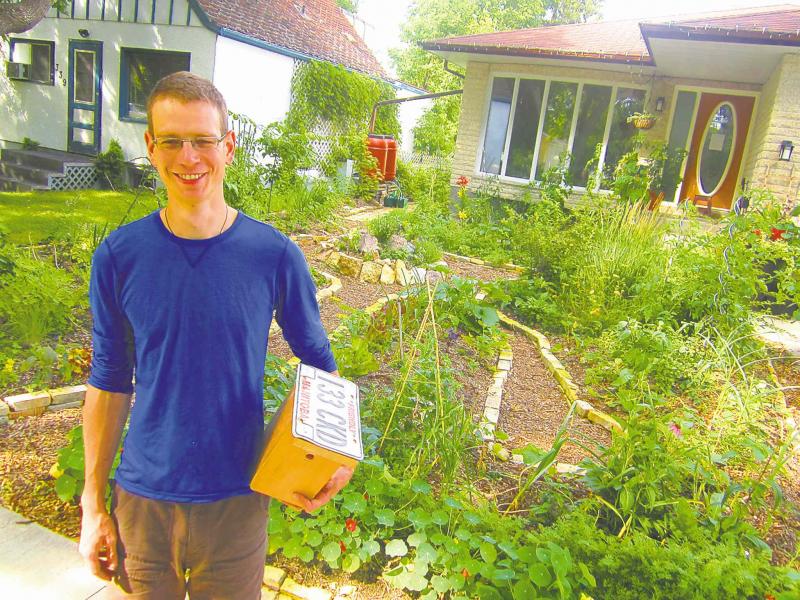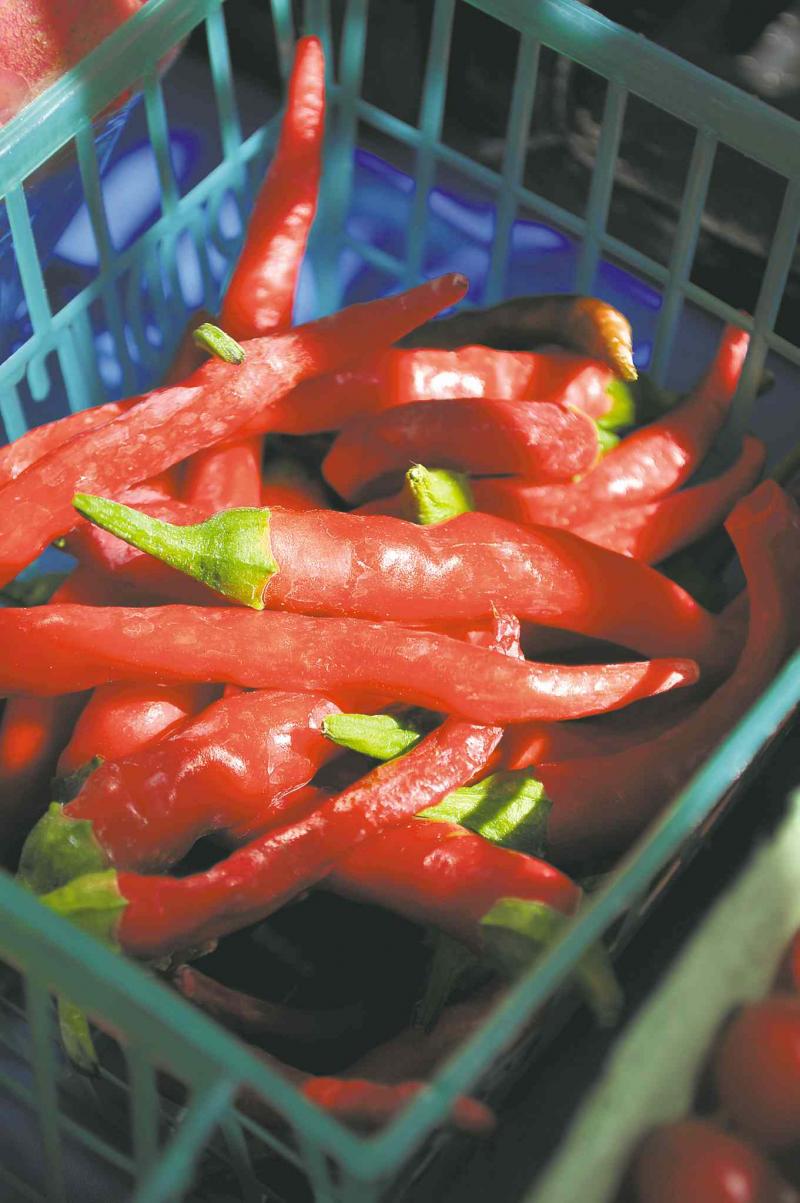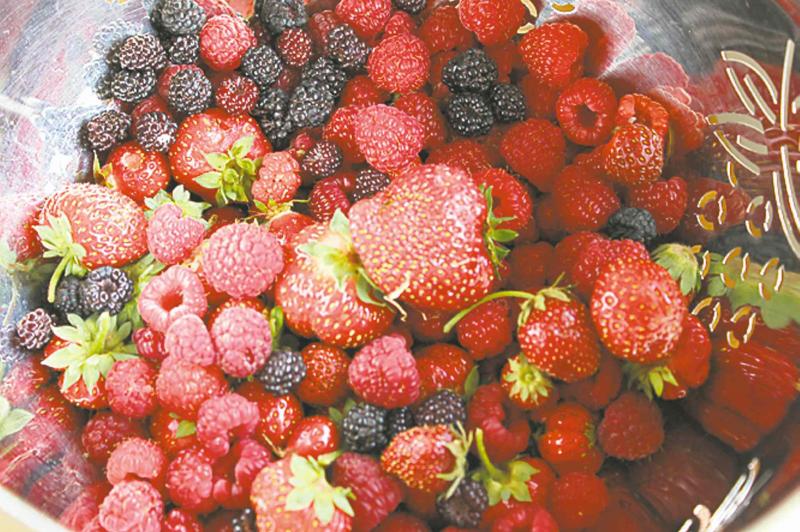


Adding edibles to the landscape can be addictive. It might start with a few carrots and tomatoes, perhaps a bit of basil and some dill or green beans -- just enough for adding fresh homegrown flavour to your recipes.
A small gooseberry or thimbleberry plant would be a treat, too, and probably wouldn't take up too much room. What about an apple tree? There are hardy new columnar varieties such as TreasuRed with a mature width of only three to four feet. How about that powerhouse of nutrition, kale, for adding to your salad or stir fry?
Before you know it, you could have your very own smorgasbord right in your backyard. Does an edible garden, though, need to be relegated to only the backyard?
In 2011, 30-somethings Monika Thiessen and Michael Thys embarked on a labour of love, transforming their entire North Kildonan property (50 ft. wide by 100 ft. deep), into an edible landscape, including the front boulevard. Vegetables, edible perennials, herbs, fruiting trees and shrubs have all been planted with a view to enjoying a continuous harvest from spring to fall.
The winners of the 2013 Manitoba Garden Makeover Viewers Choice Award, hosted by Food Matters Manitoba, their plan from the start of the project was to think beyond growing only salad ingredients and to instead enhance their daily diet with a range of fresh-grown ingredients.
Shortly after moving into her new home, Thiessen, who has a background in forest ecology and loves to get her hands dirty (she makes pottery) decided to propel her ideas for an edible garden by enrolling in a permaculture design course offered by the Harvest Moon Society.
Beginning with the process of lasagna gardening, Thiessen and Thys laid down layers of cardboard on their lawn followed by alternating layers of green organic matter such as lawn clippings and layers of brown organic matter such as dried leaves and plenty of compost to aid in decomposition.
Are edible gardens a free form potluck of plants or is structure and form every bit as important as it is in an ornamental garden? With careful attention to detail, Thiessen and Thys have maximized every square inch of their outdoor living space and created a garden that is both attractive and functional.
Using reclaimed brick to define and separate various parts of the garden, mulched pathways, design features such as a front-yard herb spiral and height variations, this well-planned landscape also includes a very unique irrigation system that incorporates the use of swales.
"We have 3,800 litres of storage space for rainwater," said Thiessen, who also makes use of two vintage white oak whisky barrels that have been modified into rain barrels. "If the rain barrels overflow, the excess water drains into swales, which are basically ditches."
Wood chips have been added to the swales, which weave their way throughout the garden and provide slow, underground watering that is delivered directly to the root zones of plants.
Thys built boardwalks to cover the drainage area. The overall result is one that is practical, economical and aesthetically pleasing.
Another principle of permaculture is to grow dynamic accumulators or plants that increase soil nutrients and in turn stimulate the growth of neighbouring plants. Call it a built-in fertilizer strategy. Leguminous plants such as crimson clover, for example, add nitrogen to the soil.
"We grow potassium accumulators such as borage," Thiessen said. "We chop some of the leaves down during the growing season, scatter them throughout the garden and let them decompose back into the soil, adding nutrients."
With gooseberries, strawberries, Nanking cherries, three varieties each of Saskatoons and raspberries as well as apples from their Prairie Magic apple tree, Thiessen and Thys have a steady supply of fresh fruit for jams, juice and preserves. Easy-to-grow ground cherries, a tart-tasting vegetable covered in a protective paper husk are combined with figs or basil for delicious tasting spreads.
Love the spiky, richly coloured blooms of Monarda, a flowering perennial, in your garden border? Thiessen said the sepals taste like oregano and adds them to her pizza sauce or sprinkles them on her salad.
The blooms of Echinacea purpurea have a practical purpose as well. Thys intends to harvest and dry the uppermost leaves and newest blooms for a flu-fighting tea.
Does an edible landscape invite an influx of hungry rabbits? Thiessen has been successful in deterring rabbits by scattering spicy-tasting mustard greens throughout her garden.
In addition to kale, Thiessen grows leafy greens that are commonly used in Asian-themed recipes such as Tatsoi (spinach mustard) and Pak Choi (Chinese cabbage).
More and more ethnically diverse vegetable crops are being grown in Manitoba -- eggplant, okra, Chinese long bean, bitter melon, Joi Choi Bok Choi, to name a few. The demand in our region pales, though, in comparison to that of Ontario where demand is so strong for locally grown world crops the Ontario Fruit and Vegetable Growers' Association has partnered with the Vineland Research and Innovation Centre to identify ethnic vegetable varieties that can be grown successfully.
Wenkai Liu, who owns and operates a commercial greenhouse in Elie, grows many diverse varieties of vegetables for sale at grocery stores and the St. Norbert Farmers Market. Wenkai said flea beetles love Chinese vegetables such as Shanghai Bok Choy, Chinese broccoli and Suey Choy cabbage, all cruciferous varieties.
"I mix up very hot peppers with ginger root and garlic and cook it down to a juice," said Wenkai, who then adds vegetable oil and sprays it on the plants. "The flea beetles hate the taste. This organic method must be repeated after a rainfall."
Marilyn Firth, executive director of the St. Norbert Farmers Market, is finding tastebuds are more adventurous and visitors to the market are very interested in experimenting with new foods.
"With all the food blogs on the Internet, there is so much more interaction between food lovers," she said.
In addition to the purple peppers, purple carrots and lime-green broccoflower that are readily available at farmers markets, kale is one of the most sought after vegetables.
"People are asking for Tuscan kale or Lacinato dinosaur kale because of its high nutrient value," said Firth. The demand is being met by more and more vendors who are growing this dark, almost blue-green variety that is used in everything from salads to soups to smoothies.
Edith Rook, of Dufferin Market Gardens in Carman, has been growing kale for 15 years, although originally just for restaurants that used it as a garnish. Rook, who said kale's popularity has exploded in the past five years, prefers the Winterbor variety.
"It can withstand some frost and you can keep picking it sometimes right until October," she said.
While the bugs also love it, "home gardeners can put netting such as pantyhose over it and it will expand with the plant as it grows," she added.
Rook has also noticed several varieties of eggplant, such as the long, slender Japanese eggplant and the small teardrop-shaped Aubergine eggplant, are becoming quite popular. While eggplant scars easily from wind, making it less desirable from a retail point of view, home gardeners need not be deterred from growing it.
How long do you have to wait before you can enjoy the fresh bounty of your garden? Not long if you are Jeannette Adams, a West Kildonan Master Gardener, who fall-seeds spinach, radish and a Mesclun mix in late October in a cold frame in a south location in her garden.
The plants come up early, as soon as the snow is gone, and Adams is able to enjoy fresh-picked greens before the end of May.
"Once the snow melts in spring, we put the windows on the cold frame to warm up the soil and the plants start to come up for an early crop," she said.
How early? Adams and her family enjoy an early harvest by the end of May and before they begin planting in the garden for a summer long harvest.




